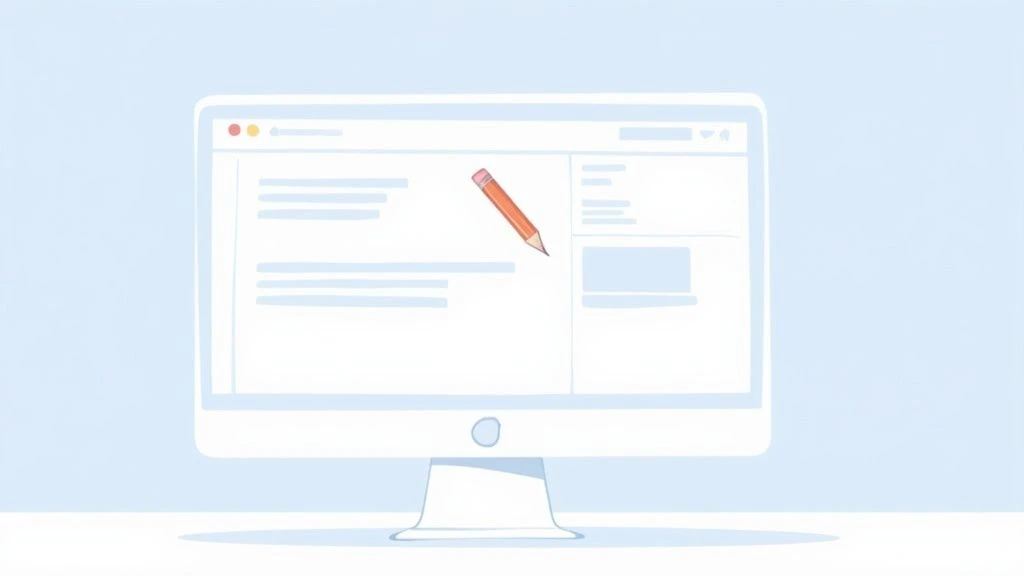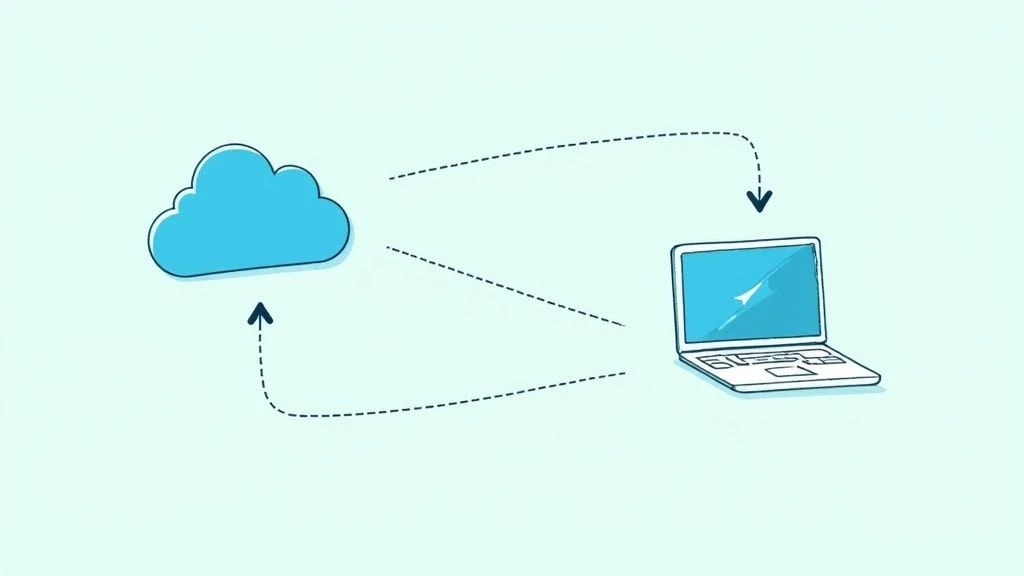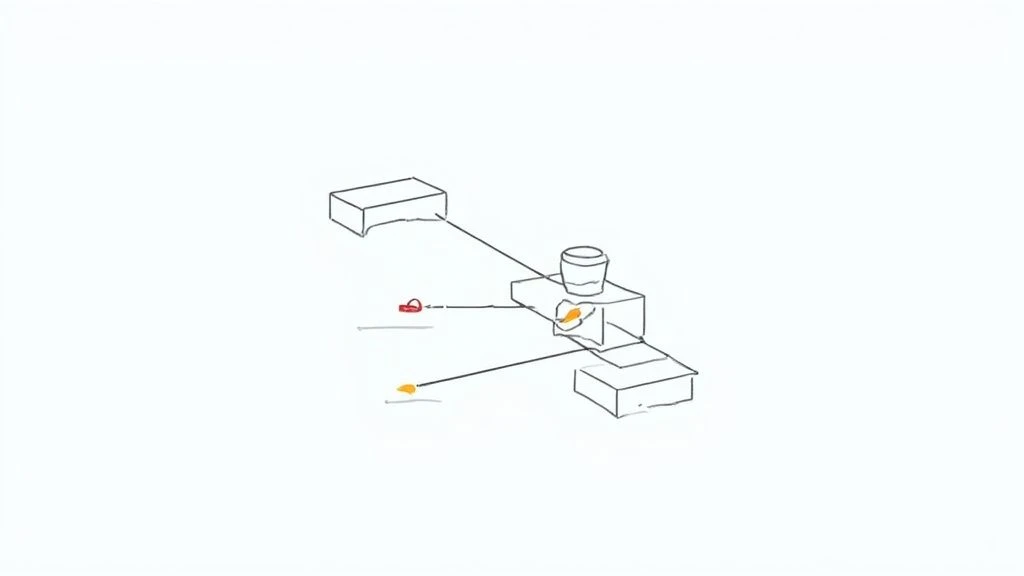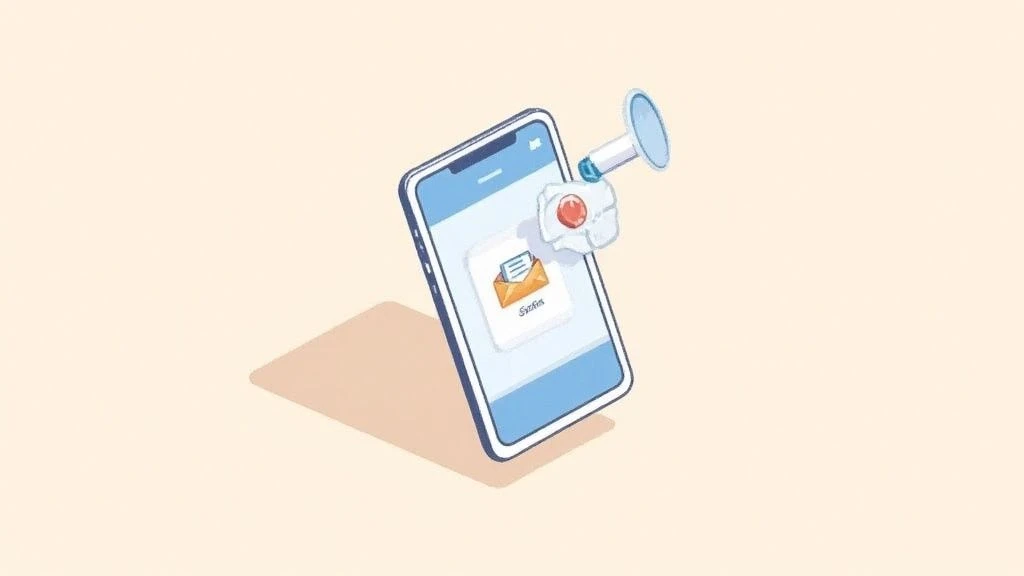How Do Emails Work? Uncover Email Technology
April 11, 2025The Evolution of Email: From Digital Novelty to Communication Backbone

In the nascent stages of computing, email emerged as a groundbreaking form of communication, a digital whisper across expanding networks. The first email, sent in 1971 by Ray Tomlinson, marked a pivotal moment. This initial message, likely a simple test, laid the groundwork for a communication shift. In its early days, email was primarily used by computer enthusiasts and researchers.
From ARPANET to Global Phenomenon
Throughout the 1970s and 80s, email adoption grew steadily, largely within academic and government circles. With the rise of the internet and the arrival of user-friendly email clients like AOL in the 1990s, email's popularity exploded. Services like Hotmail brought email to the masses. This era marked email’s transition from a niche technology to a mainstream communication method.
Email communication has experienced remarkable growth. The number of global email users has skyrocketed from a mere 10 million in 1997 to approximately 4.48 billion by 2024. This represents a staggering 44,710% increase, solidifying email's place as a vital communication component worldwide. As of 2024, 56.8% of the global population uses email, a figure projected to reach over 4.85 billion users by 2027. For more detailed statistics, check out this resource: Email Stats.
Adapting to the Modern Age
Despite the rise of instant messaging, social media, and other communication platforms, email remains a core communication tool. This resilience stems from email's inherent advantages: its asynchronous nature, formal structure, and established role in business and official correspondence. For tips on managing your inbox effectively, see How to Master Your Inbox. Furthermore, email has adapted to the evolving technological landscape.
Ensuring Security and Reliability in the Digital Age
For instance, the development and implementation of security protocols like SPF, DKIM, and DMARC have significantly enhanced email security and reduced spam. The continuous evolution of email clients, incorporating features like advanced search, automated filtering, and integration with other applications, has also contributed to its enduring relevance. This ongoing development ensures email remains a dynamic and vital tool for communication, business, and navigating the modern world.
How Do Emails Work: The Essential Technical Architecture

Understanding how email works can seem daunting, but it's really just a series of interconnected steps. This section breaks down the core components and processes that make sending and receiving emails possible. Think of it like exploring the inner workings of a complex, yet efficient, machine.
The Three Pillars of Email Communication
The email system relies on three primary elements: Mail User Agents (MUAs), Mail Transfer Agents (MTAs), and Mail Delivery Agents (MDAs). These components work together seamlessly, much like the different parts of a postal system.
-
Mail User Agents (MUAs): These are the email clients you interact with every day, such as Gmail, Outlook, or Apple Mail. MUAs are your interface for composing, reading, and organizing emails. They're like your local post office where you send and receive mail.
-
Mail Transfer Agents (MTAs): MTAs work behind the scenes, routing emails across networks. Their job is to transfer messages from the sender's MUA to the recipient's MDA. Think of them as the mail trucks and sorting facilities that move messages between locations.
-
Mail Delivery Agents (MDAs): MDAs receive incoming emails from MTAs and place them into the recipient's mailbox. They're the final step in the email journey, ensuring messages reach their intended destination. MDAs are like the mail carrier who delivers the letter to your doorstep.
The Role of Email Protocols
These components communicate using established email protocols, which are sets of rules that govern their interactions. Key protocols include SMTP, POP3, and IMAP. Understanding these protocols is fundamental to grasping how email functions.
-
Simple Mail Transfer Protocol (SMTP): This is the standard protocol for sending emails. SMTP manages the transfer of messages between MTAs, making sure your email gets routed correctly across the internet. It's like the addressing system used by the postal service, guiding mail to the right location.
-
Post Office Protocol version 3 (POP3): POP3 retrieves emails from a server and downloads them to your local device. Once downloaded, the messages are typically removed from the server. This is like picking up your physical mail from the post office and taking it home.
-
Internet Message Access Protocol (IMAP): Unlike POP3, IMAP lets you access and manage emails directly on the server. This allows you to check your email from multiple devices, keeping your messages synchronized across all of them. It's like having a virtual mailbox you can access from anywhere.
To illustrate the key differences between these essential email protocols, let's take a look at the following table:
Email Protocols Comparison: A comparison of the major email protocols showing their functions, purposes, and key differences
| Protocol | Primary Function | Port Numbers | Security Features | Modern Usage |
|---|---|---|---|---|
| SMTP | Sending emails | 25, 587, 465 | STARTTLS, SSL/TLS | Standard for sending emails |
| POP3 | Receiving emails (download and delete) | 110, 995 | SSL/TLS | Less common, suitable for single device access |
| IMAP | Receiving emails (access on server) | 143, 993 | SSL/TLS | Most common, ideal for multiple device access |
This table highlights how each protocol plays a specific role in managing email communication, from sending messages to retrieving them on different devices. The increasing importance of accessing email from multiple devices makes IMAP the most prevalent protocol for receiving emails today.
Understanding the Flow of Email
When you send an email, your MUA uses SMTP to connect with an MTA. The MTA uses the recipient's email address to find their MDA, typically linked to their email provider's server. Finally, the MDA delivers the message to the recipient's inbox, accessible through their chosen MUA. This entire process often takes mere seconds, even for emails traveling across the globe.
This coordinated operation of MUAs, MTAs, and MDAs, all governed by specific email protocols, is what enables email communication. These components work together seamlessly, handling the vast number of messages sent and received daily.
The Email Journey: Following Your Message Across Networks

From the moment you click "send," your email begins a complex journey across various networks. It can travel across continents in mere seconds. This intricate process involves a series of interactions between servers. Each server plays a vital role in ensuring your message reaches its recipient. Let's explore this fascinating journey and see how email works behind the scenes.
Mapping the Route: How Emails Find Their Way
An email's path isn't random. Sophisticated systems work to find the best route for your message. Think of it like a GPS finding the fastest way to your destination. These systems consider factors like network traffic, server availability, and distance. This efficient routing directs the flow of email traffic. Understanding how this works involves explaining specific technical terms, highlighting the importance of clear communication in technical fields. Good technical communication skills are essential for explaining this complex process.
Negotiating Security: Protecting Your Message En Route
Security is critical during the email journey. As your message travels, servers use security protocols to protect it from unauthorized access. This involves encryption and authentication. These mechanisms verify the sender and protect the message's contents. Security measures are always being updated to combat new threats and keep your communication safe.
Navigating Filters: Avoiding the Spam Trap
Email filtering systems act like gatekeepers. They examine incoming messages for spam and other harmful content. These systems look at several things, including sender reputation, keywords in the content, and technical settings. This helps determine if a message is legitimate or should be flagged as spam. Filtering is vital for keeping inboxes clean and preventing unwanted emails.
By the end of 2024, global email users are projected to reach 4.6 billion. This shows how important email remains. With an estimated 361.6 billion emails sent daily, strong filtering is essential. You can find more detailed email statistics here.
Delivery Delays: Why Some Emails Take Longer
Many emails arrive instantly, but others are delayed. Several things can cause these delays. Network congestion, server problems, and the recipient's server processing time can all contribute. Large attachments or complicated formatting can also slow down delivery. Knowing these factors can help you understand potential delays and manage your expectations.
The Human Element: Sender Reputation and Content Impact
Beyond the technical side, human factors also affect email delivery. A sender's reputation is key to whether an email lands in the inbox or the spam folder. Consistent sending habits, engaging content, and avoiding spam triggers help build a positive reputation. Sending bulk unsolicited emails or using misleading subject lines can harm your reputation and prevent emails from reaching their destination.
Understanding the steps of the email journey—from routing and security to filtering and delivery—provides valuable insight into how email works. This knowledge helps you improve your email practices, increase delivery rates, and ensure your messages reach their intended recipients.
Securing The Digital Envelope: Email Authentication Methods

Understanding the email journey is key to appreciating the security measures that protect our inboxes. How can we be sure an email truly originates from the sender it claims? This is where email authentication becomes vital. These behind-the-scenes methods verify sender legitimacy and combat malicious activities like spoofing, where attackers forge email headers to impersonate other senders.
The Security Triangle: SPF, DKIM, and DMARC
SPF (Sender Policy Framework), DKIM (DomainKeys Identified Mail), and DMARC (Domain-based Message Authentication, Reporting & Conformance) form a crucial security triangle. Each protocol plays a distinct role in verifying sender identity and protecting against fraudulent emails. For added security, consider how to turn cold email click-throughs into warm conversations, particularly valuable in combating phishing.
-
SPF: This protocol designates authorized mail servers for a domain. Think of it as a gatekeeper for your domain's "return address," preventing attackers from sending emails appearing to originate from your domain.
-
DKIM: DKIM digitally signs each email, verifiable by the recipient's server. This signature acts as a tamper-proof seal, confirming message integrity and assuring the content hasn't been altered in transit.
-
DMARC: Building upon SPF and DKIM, DMARC instructs receiving servers on handling emails that fail authentication checks. Actions range from rejecting the message to sending it to spam, empowering domain owners to control their email reputation.
These three protocols work in concert, forming a robust defense against email spoofing and phishing attacks, ensuring secure email communication. For businesses handling sensitive customer information, enhancing email security goes hand in hand with implementing robust support systems like those discussed in How to master email ticketing.
Encryption Protocols: Shielding Your Message Content
Beyond sender authentication, encryption is essential for safeguarding email content. Encryption transforms readable text into an unreadable format, accessible only to authorized parties.
-
TLS (Transport Layer Security): TLS encrypts the connection between email servers, protecting messages as they traverse the internet. Imagine it as a sealed envelope, safeguarding your message in transit.
-
S/MIME (Secure/Multipurpose Internet Mail Extensions) and PGP (Pretty Good Privacy): These protocols offer end-to-end encryption, meaning only the sender and recipient can decrypt the message. They function like a unique lock and key, ensuring complete confidentiality, even from email providers.
While TLS is widely implemented, S/MIME and PGP often require more technical configuration. However, they offer the highest level of protection for sensitive information.
To understand the various email security protocols, their functions, and implementation requirements, refer to the table below:
Email Security Protocols
| Protocol | Purpose | Implementation Level | Effectiveness | Adoption Rate |
|---|---|---|---|---|
| SPF | Specifies authorized mail servers for sending emails on behalf of a domain. | Relatively simple, requires DNS record updates. | Effective in preventing spoofing but reliant on DMARC for enforcement. | High |
| DKIM | Adds a digital signature to emails, verifying message integrity. | Moderate, involves generating and adding keys to DNS records. | Highly effective in preventing message tampering. | Increasing |
| DMARC | Instructs receiving servers on handling emails that fail SPF and DKIM checks. | Moderate, requires DNS record updates and policy definition. | Very effective in controlling domain reputation and preventing fraudulent email use. | Growing |
| TLS | Encrypts the connection between email servers, protecting messages in transit. | Widely implemented by email providers, generally automatic. | Effective in protecting against eavesdropping during transit. | Very High |
| S/MIME & PGP | Provide end-to-end encryption, ensuring only the sender and recipient can decrypt the message. | More complex, requires software installation and key management. | Highest level of protection for message confidentiality. | Lower, often used for highly sensitive communications. |
This table summarizes the core aspects of email security protocols, highlighting their varying implementation complexities and levels of protection. Choosing the right combination of protocols depends on the specific security needs and technical capabilities of an organization. Email security is constantly evolving to address new threats, ensuring email remains a secure and dependable communication tool.
Enterprise Email Systems: Scaling for Business Success
Building and maintaining a reliable email system for a large organization is much more complex than simply setting up a few personal email accounts. Enterprise email systems face significantly greater challenges. They must handle immense volumes of messages, all while ensuring security, reliability, and seamless integration with other essential business applications. This section explores the intricacies of enterprise email infrastructure and the strategies used to address these challenges.
Key Considerations for Enterprise Email
Several critical factors influence the selection of an enterprise email solution. These considerations span cost, control, compliance, and compatibility:
- Cost Implications: Setting up an on-premises solution requires a significant upfront investment in both hardware and software. In contrast, cloud-based solutions offer predictable subscription pricing.
- Control Requirements: On-premises systems give organizations greater control over their data and security. Cloud solutions, however, offer more convenient management and easier scalability.
- Compatibility Needs: Integration with existing business applications, such as Customer Relationship Management (CRM) and Enterprise Resource Planning (ERP) systems, is crucial for a streamlined and efficient workflow.
Choosing the best solution involves carefully balancing these factors against the organization's specific needs and available resources. Email remains a critical communication tool for businesses. In 2023, businesses exchanged a staggering 347 billion emails daily, and this number is projected to reach 376 billion by 2025. This demonstrates the continuing importance of email, even with the rise of other communication platforms. Find more detailed statistics here. You might also be interested in: How to pick the best helpdesk software for small business.
Managing Email Archiving and Disaster Recovery
Enterprise email systems must address two critical operational aspects:
- Email Archiving: Maintaining email data for compliance and legal reasons is essential. Archiving solutions ensure the secure storage and readily available retrieval of past communications.
- Disaster Recovery: Strong disaster recovery plans are vital for safeguarding against data loss. These protocols ensure business continuity in the event of server failures or other unexpected events.
Meeting Compliance Requirements
In today's heavily regulated environment, enterprise email systems must adhere to strict compliance standards:
- Data Privacy: Regulations like the General Data Protection Regulation (GDPR) and the California Consumer Privacy Act (CCPA) mandate strict data privacy measures. These regulations govern how organizations handle personal information transmitted via email.
- Industry-Specific Regulations: Certain industries, such as finance and healthcare, are subject to specific regulations for email communication and data retention. These specific regulations heavily influence how organizations manage and store their email data.
Real-World Case Studies and Best Practices
Learning from major corporations and their email management strategies can provide valuable insights. Real-world case studies showcase best practices and successful implementations. These examples can guide other organizations facing similar email management challenges. For instance, during the 2020 pandemic, many companies saw a 20-30% increase in email traffic due to the increase in remote work. This surge highlighted the critical role email plays in maintaining business operations.
The Value of Enterprise Email Solutions
Robust enterprise email systems are vital for maintaining efficiency and competitiveness. By addressing the challenges associated with large-scale email management, organizations ensure seamless communication, protect valuable data, and meet evolving compliance standards. These systems facilitate streamlined workflows and support critical business functions. They allow organizations to focus on core operations with the confidence that their communication infrastructure is secure and reliable.
The Future of Email: Innovation in Your Inbox
Email remains a cornerstone of communication, but it's constantly evolving. New innovations are shaping how we interact with our inboxes, promising a more streamlined, secure, and personalized experience. From artificial intelligence to enhanced accessibility, these advancements are transforming communication, collaboration, and connection.
The Rise of Intelligent Email
Artificial intelligence (AI) is changing how we manage email. Smart features are becoming increasingly common, helping us prioritize messages and write more effectively. Predictive prioritization analyzes your email habits to highlight the most important messages, ensuring you don't miss critical communications. Smart composition tools, like those found in Grammarly, assist with writing, offering suggestions for wording, tone, and grammar, ultimately enhancing writing quality.
Imagine an AI that learns which emails you typically open first and prioritizes similar messages in the future. This intelligent filtering can save valuable time and reduce inbox clutter. Think about composing an email and having AI suggest more professional phrasing or identify potential grammatical errors. This improves clarity and professionalism.
Interactive Experiences Within Your Inbox
AMP for Email allows for interactive experiences directly within messages. This means you can perform actions within the email itself, without opening new tabs or windows. This has a significant impact on how businesses interact with customers.
Imagine completing a survey, RSVPing to an event, or browsing a product catalog directly within your inbox. This streamlined approach increases engagement and efficiency, allowing for a more dynamic and convenient email experience. This change in how we interact with email can boost productivity and transform email into a more versatile platform.
Accessibility and Inclusivity for All
Innovations in accessibility are making email more inclusive. Features like screen readers and keyboard navigation ensure everyone can use email, regardless of their abilities. This focus on inclusivity guarantees equal access to this vital communication tool. This improvement is a fundamental step towards a more equitable digital experience.
Privacy-Centered Design: Reshaping the Email Ecosystem
Privacy is paramount. Privacy-centered design is at the forefront of email development, with providers implementing robust encryption and authentication protocols. These efforts focus on securing messages and protecting data from unauthorized access, strengthening trust in email communication. As email evolves, ensuring privacy will remain a top priority. These advancements maintain user confidence and secure sensitive information.
End-to-end encryption, discussed by Google Workspace, is becoming more user-friendly for all organizations, ensuring even the most sensitive emails remain private. This move towards accessible encryption highlights the growing importance of privacy.
The Email of Tomorrow: A Look Ahead
These developments represent a significant shift in how we use email. The future of email is an intelligent, interactive, and secure platform. These changes will improve individual experiences and transform how businesses communicate with customers and how teams collaborate. This ongoing evolution will shape the future of communication and ensure email remains relevant in an ever-changing technological world.
Ready to transform your customer support with an innovative email ticketing system? Aidlify streamlines your workflow, enhances team collaboration, and boosts customer satisfaction. Learn more about Aidlify and revolutionize your support process.